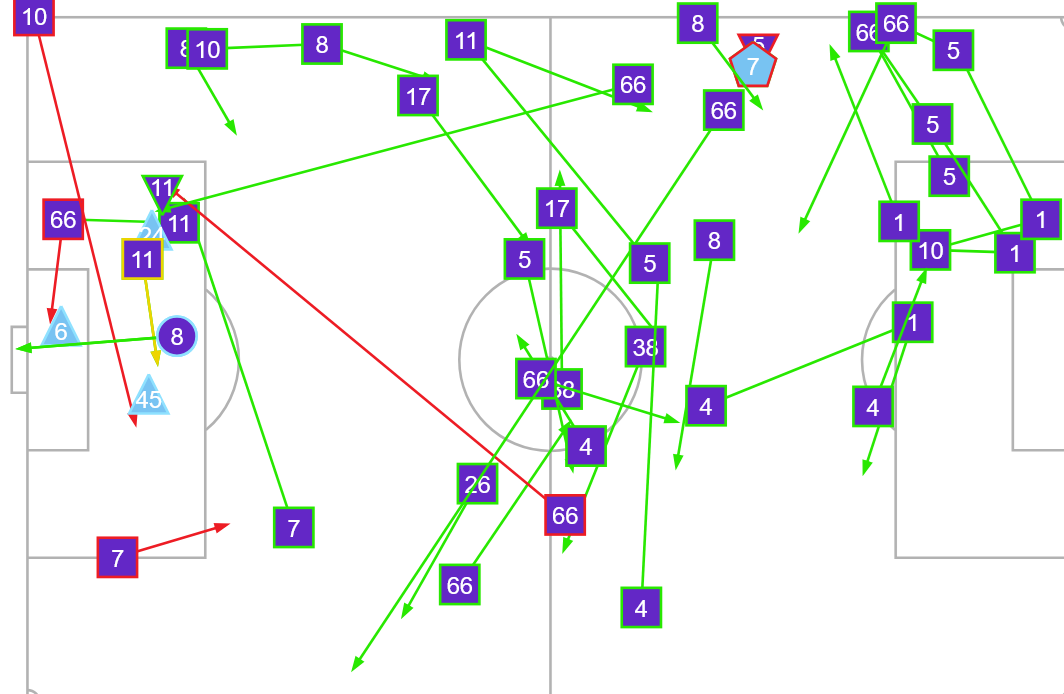Stat of the Match: Manchester City 0-2 Liverpool
Liverpool negotiated one of their toughest remaining fixtures of their Premier League title charge in style. Here's how they did it.
Some people have believed that Liverpool will win the 2024/25 Premier League for a long time. After they beat Manchester City at the Etihad Stadium, there will be few who think otherwise now.
Football writer Jonathan Wilson recently penned an article in which he declared 2-0 victories to be the hallmark of champions. “It’s a scoreline that speaks of control, of winning games with a little to spare, taking freakish equalisers, ill luck and odd refereeing decisions out of the equation, without being flashy and demanding overexertion,” he wrote.
That sentence alone could serve as a reasonable summary of the Reds’ latest victory. The win over City was their seventh 2-0 triumph in the league this season, the club’s most in a single Premier League campaign.
It was the type of seismic win for which the post-match trivia alone would fill an article guaranteed to entertain Liverpool supporters. Their side became the first to beat the Cityzens to nil home and away since 2009/10. Even a pair of league clean sheets against them is rare enough, with the Reds just the fourth team to achieve this in the Pep Guardiola era.
Perhaps best of all, Liverpool inflicted a two-goal home defeat upon one of their arch rivals. It is something they themselves have not had to endure for a very long time.
As hard as it feels to think this given the history of the fixture, we should have expected an away win. Liverpool became the first visiting team at the Etihad to be favoured to win by bookmakers since City’s current managerial tenure began in 2016. Whatever your opinion of the gambling industry, bookies don’t get their predictions wildly wrong too often.
For the second game running, Liverpool’s starting XI only contained two of their six forwards. However, at Aston Villa in midweek, Slot broadly stuck to his established 4-2-3-1 formation whereas here it was a… what, exactly? Opta listed it as 4-2-2-2, with Curtis Jones and Dominik Szoboszlai as the forwards in front of Luis Díaz and Mohamed Salah.
Formations are always in the eye of the beholder, differing whether in or out of possession to bamboozle simple numerical listings. At times in the first half it looked almost 4-2-4, or if a 4-2-2-2, then one with the traditional forwards as the front two but in wide areas. False nines? Hidden 10s? Subliminal eights? A minor suspended seventh chord? Who cares, it worked.
The fluid, flexible formation led to some really interesting movements. At one point Jones dropped back to press someone, but rather than holding his nominal position, Alexis Mac Allister moved forward to where his Liverpudlian colleague previously was. There was always a Red where one needed to be, from first whistle to last.
Later in the first half, the Argentine was then stationed between the centre halves, clearing the ball from near the penalty spot. A manager like Roy Hodgson would approach the task of City away with static lines, lining up two banks of four or five. As much as Liverpool employed a degree of that style, particularly when protecting their lead as the match wore on, it was as if the players were on vertical sliders, moving perfectly up and down the pitch for each other too.
The Reds took the lead thanks to a well-worked corner routine. It’s great that Liverpool don’t have an attention-drawing set piece coach (yet), though the man currently responsible for the dead ball plans, Aaron Briggs, shared a moment with Slot on the sidelines after the opening goal had been scored.
As you would expect from a goal of that nature, it was no accident. Former Reds midfielder Jay Spearing spoke about this on LFCTV after the game. He is at the club as an overage player-cum-coach with the youth teams. They provide the opposition for the senior side when required in training.
“So, yesterday [Saturday], we did set pieces and we were undone with the exact same set piece, which I don't mind because it's obviously worked today and we got us a goal,” Spearing said. “It's fantastic work and credit to Aaron as well… he's done incredible things and it's finally worked on one of the biggest stages in the biggest games of the season.”
Having mentioned the value of set piece balance after the draw with Aston Villa, Slot highlighted it once again following this game. Liverpool have seen the power of dead ball situations for bad then good in their previous two matches.
As great as the first goal was, the second was even better. It could, maybe should, have arrived earlier than it did. With 33:27 on the clock, the Reds took a goal kick. They played out well through City pressure, with the ball eventually reaching Salah who had Trent Alexander-Arnold overlapping on his outside. Had he then pulled the back towards the penalty spot rather than drilling it into the six-yard box, Díaz may have scored.
No matter. The move earned Liverpool a corner, and though that led to nothing, City did not regain possession until Szoboszlai put the ball into their net at 36:51. Here’s the full data from the aforementioned goal kick to the Reds going 2-0 up. All the home side were able to muster in roughly three-and-a-half minutes were three clearances in their box and a foul by Omar Marmoush (7) on the impeccable Ibrahima Konaté.
From there, the match largely became about attack versus defence, albeit it was Liverpool who later crafted the only Opta-defined big chance of the contest. Salah found Szoboszlai in the centre of the box - more on that later - though Abdukodir Khusanov recovered well to block the Hungarian’s shot.
Back to City going forward, the numbers for which make for bleak reading from their perspective. The soon to be deposed champions generated just 0.6 expected goals, their second lowest tally in a home game in leagues Champions or Premier since 2017. As this attacking gruel was spread across 16 goal attempts, they carried an average value of just 0.04 per shot, a new low at the Etihad.
Guardiola’s side had the most sterile of domination. Only five times in the last eight seasons has a team completed more passes than the 618 City logged here without managing to produce at least 0.7 xG. By succeeding with over 300 passes more than Liverpool, this match featured the Reds’ lowest possession figure in a Premier League victory since records began in 2003.
A big part of the problem for the home side was Jeremy Doku. He repeatedly dribbled past Alexander-Arnold as you can see here; the stars denote the City winger’s take-ons, the crosses the Liverpool right-back’s attempted tackles, with green signifying success.
But very little happened of note after the completed dribbles, as was the case in this fixture last season. Doku had a direct hand in seven shots, the most potent of which was worth a mere 0.05 expected goals. As is so often the case, Neil Atkinson of The Anfield Wrap summed a situation up superbly:
Despite the reigning champions’ dominance of possession, the difference for completed passes that either began or ended in the opposition box was just three. Liverpool’s wall of a defensive block is best illustrated by a map of City’s chance creating passes. Over half of them went away from goal, with just one ending in the danger zone which stretches from the width of the six-yard-box out to the edge of the penalty area.
City didn’t complete a regular pass into this central section of the Reds’ box until stoppage time. While there were a couple of successful crosses, only one created a chance (as you can see above, ending near the penalty spot). It was a blocked header worth 0.02 xG; it barely warrants a mention.
The touch data continues this theme. The Citzens’ total of 37 in the box is the joint-fifth most Liverpool have allowed in their last 293 League games. But again, there were very few in the danger zone, marked with a white square here.
No matter what they tried, City could rarely break through into the areas which matter most. They were often closed down at every turn.
The Reds displayed the value of pressing for their first goal, with Jones regaining the ball high up the pitch with the subsequent sequence resulting in the crucial corner. This was clearly one game in which it mattered more from a defensive standpoint though.
Liverpool recorded 265 pressures, per Fantasy Football Scout, their second most of the campaign behind the home win over Brighton. Again, this is game state and possession influenced, but with 53, Szoboszlai made at least 12 more than any other player in the Premier League this weekend. It’s also a high watermark for a Red in 2024/25. No wonder he fell to the deck at full time, before admitting in his post-match interview that he was too tired to hear the travelling Kop.
The work rate and determination Liverpool displayed is perhaps best summarised by Wataru Endō’s cameo. He played 17 minutes essentially in the position in which Nico González played 78 for City. They made 14 pressures each.
In baseball, teams have a relief pitcher known as a closer. They come on for the final inning of a tight game to ensure the opposition team does not score a run to change the result. Endō is proving to be Slot’s closer. What a dashboard he had at the Etihad; only one pass, accompanied by two successful tackles, a clearance and a cross block. His only interest in the ball was stopping it, changing it’s trajectory.
To prove that stats are meaningless, Liverpool had a higher xG figure when they lost 4-0 behind closed doors at the Etihad in 2020 than they did on Sunday. But on that day, almost five years ago, they were still celebrating having won the title. They’ll be able to do that again within the next three months, but it won’t be City able to take advantage this time.















Lovely read.
Thank you!
The table with the 2-0+ defeats is astonishing....Liverpool should set up an Only Fans account ;P
Great reflection on a great game!